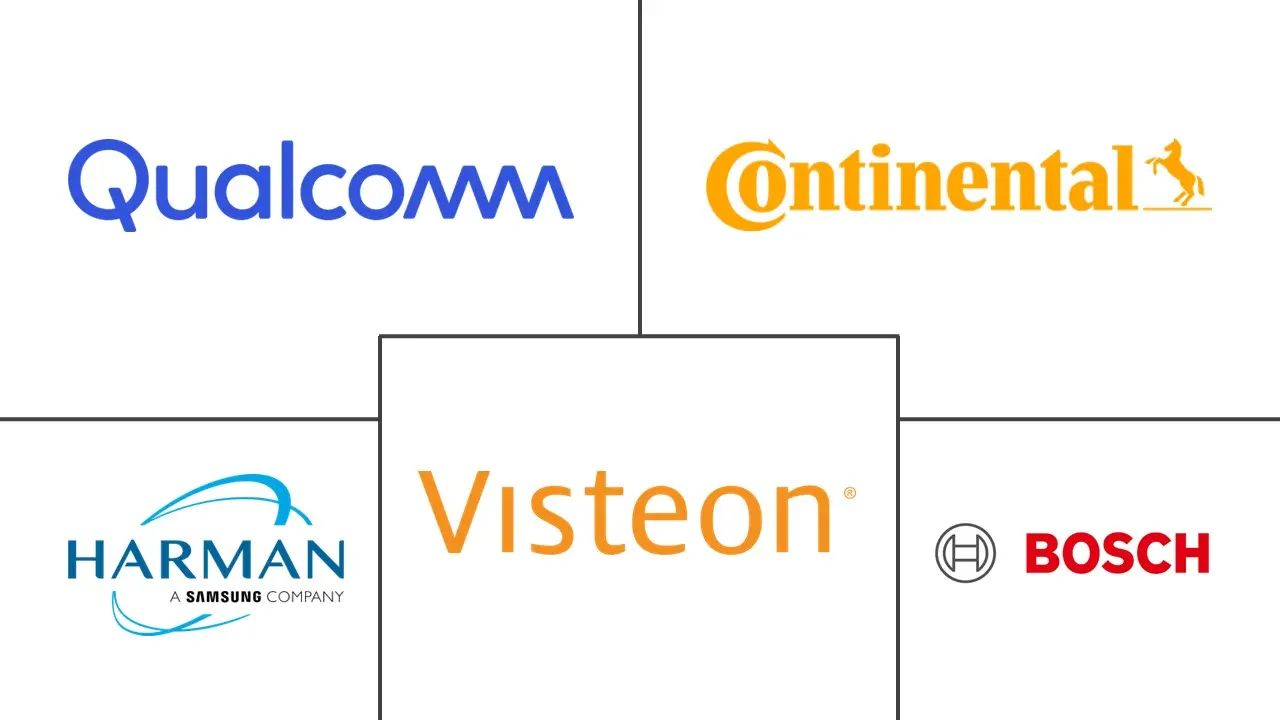Connected Vehicle Market Size and Share
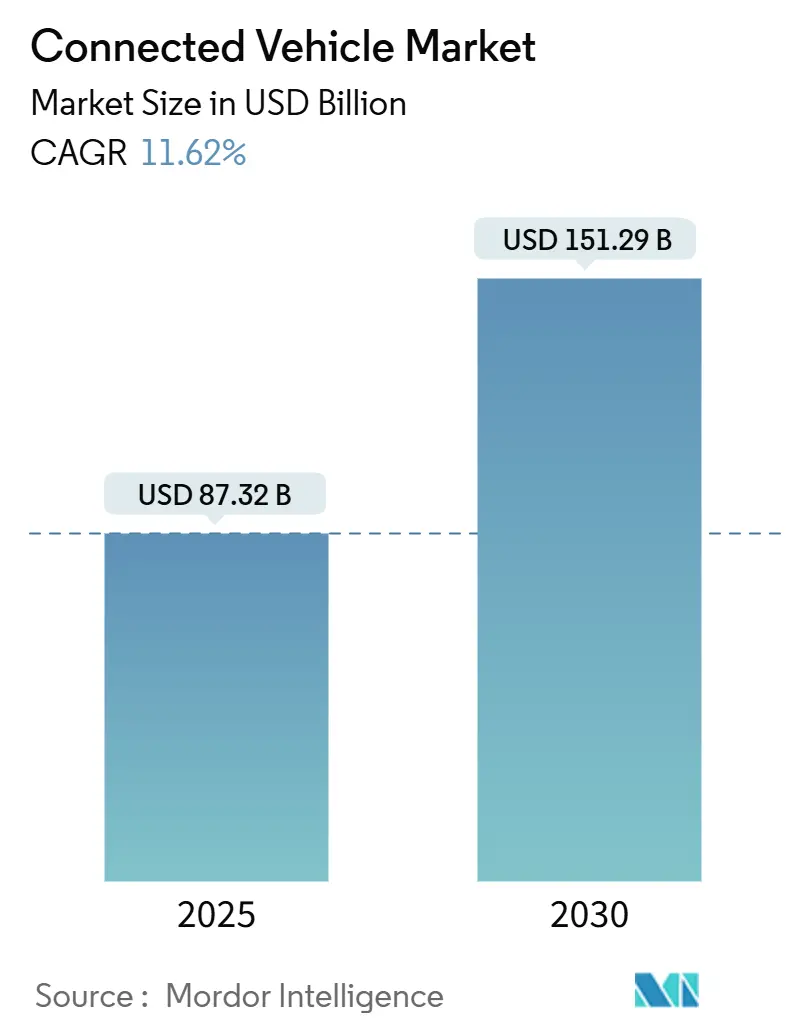
Connected Vehicle Market Analysis by Mordor Intelligence
The connected vehicle market reached USD 87.32 billion in 2025 and is projected to climb to nearly USD 151.29 billion by 2030, reflecting an 11.62% CAGR. Accelerating software-defined architectures, new cybersecurity mandates, and global 5G rollouts together redraw profit pools as connectivity outshines traditional mechanical benchmarks. The EU eCall requirement and UN ECE R155 cybersecurity rule guarantee a baseline telematics layer in every new model, reshaping OEM roadmaps and raising entry barriers[1]“Mandatory Digital Shield for All New Cars This Year,” TÜV SÜD, tuvsud.com. Across Asia-Pacific, government-backed 5G expansion underpins Vehicle-to-Everything (V2X) services, giving the region an edge as the fastest-growing geography in the connected vehicle market. Automakers now favor embedded solutions that support over-the-air (OTA) updates, subscription revenue, and data monetization, even as suppliers rush to harden software against rising cyber threats.
Key Report Takeaways
- By technology type, 4G/LTE retained 41.62% of connected vehicle market share in 2024, while 5G/C-V2X is forecast to expand at a 17.96% CAGR through 2030.
- By application, Safety & Driver Assistance led with 36.74% revenue share in 2024; OTA updates will grow at a 15.33% CAGR to 2030.
- By connectivity, integrated solutions commanded a 44.85% share of the connected vehicle market size in 2024, whereas embedded solutions posted the highest 14.06% CAGR.
- By vehicle connectivity, V2V held the leading share of 46.17% in 2024; V2G is scaling the fastest at a 20.94% CAGR through 2030.
- By vehicle type, passenger cars captured 71.24% share of the connected vehicle market size in 2024 and will grow at a 12.37% CAGR.
- By end market, OEM-fitted platforms accounted for 87.10% of 2024 revenues and will rise at a 12.71% CAGR.
- By geography, Europe led with 33.55% share in 2024, while Asia-Pacific is set for a 13.90% CAGR through 2030.
Global Connected Vehicle Market Trends and Insights
Drivers Impact Analysis
| Driver | (~) % Impact on CAGR Forecast | Geographic Relevance | Impact Timeline |
|---|---|---|---|
| Regulatory Mandates for Ecall and Safety Telematics | +3.2% | Europe, North America, expanding to Asia-Pacific | Short term (≤ 2 years) |
| Global 5G Rollouts Enabling High-Bandwidth V2X Services | +2.8% | Global, with China and South Korea leading | Medium term (2-4 years) |
| Consumer Demand for In-Car Infotainment & Connectivity | +2.1% | Global, strongest in China and North America | Medium term (2-4 years) |
| Smart-Infrastructure Funding In the US, EU, and China | +1.9% | North America, Europe, China | Long term (≥ 4 years) |
| EV-Centric Software-Defined Vehicle Architectures | +1.4% | Global, led by China and Europe | Long term (≥ 4 years) |
| Insurance-OEM Usage-Based-Insurance Partnerships | +0.8% | North America, expanding to Europe | Medium term (2-4 years) |
| Source: Mordor Intelligence | |||
Regulatory mandates for eCall & safety telematics
The EU General Safety Regulation, effective July 2024, requires intelligent speed assistance, automated emergency braking, and event data recorders in every new vehicle. Automakers thus harmonize global platforms to the strictest rule set, compressing cost and accelerating feature rollout. Certified component suppliers enjoy short-term pricing power as OEMs race for compliance. Insurers simultaneously gain standardized crash data streams that sharpen risk models, sustaining momentum for the connected vehicle market.
Global 5G rollouts enabling high-bandwidth V2X services
China installed more than 5 million 5G base stations by 2025—1.5 times its 4G investment, essential for cooperative driving and high-definition mapping[2]“China Mobile: 5G Rising,” Citigroup, citigroup.com. Dual-modem designs bridge legacy 4G while optimizing 5G, raising the bill of materials but widening the service scope. First movers capture experiential advantages, while laggards risk obsolescence as consumers normalize around instantaneous data delivery.
Consumer demand for in-car infotainment & connectivity
Surveys show 39% of buyers prefer annual subscriptions for software features, steering OEMs toward recurring revenue streams. Chinese customers display the highest willingness to pay, shifting showroom narratives from horsepower to app ecosystems. Cost sensitivity in other regions pushes tiered bundles that balance affordability and functionality, but Generation Z’s digital-native preferences provide a demographic tailwind through 2030.
Smart-infrastructure funding in the United States, EU, and China
US DOT SMART grants finance Vehicle-to-Infrastructure (V2I) pilots across major metro areas US[3]“SMART Grants Program,” US Department of Transportation, transportation.gov. Europe’s Connecting Europe Facility aligns roadside units across borders, while China synchronizes 5G expansion with urban traffic platforms, creating integrated mobility corridors. These programs resolve the historic chicken-and-egg dilemma, broadening the addressable base for connected vehicle market services.
Restraints Impact Analysis
| Restraint | (~) % Impact on CAGR Forecast | Geographic Relevance | Impact Timeline |
|---|---|---|---|
| Cyber-Security and Data-Privacy Vulnerabilities | -2.2% | Global, stricter in Europe due to GDPR | Short term (≤ 2 years) |
| High Cellular Data Costs and OEM–MNO Revenue Conflicts | -2.1% | Global, acute in emerging markets | Medium term (2-4 years) |
| DSRC Vs C-V2X Spectrum Uncertainty | -1.7% | North America, some European markets | Medium term (2-4 years) |
| Semiconductor Modem Shortages | -1.5% | Global, supply chain dependent | Short term (≤ 2 years) |
| Source: Mordor Intelligence | |||
Cyber-security & data-privacy vulnerabilities
Modern vehicles contain roughly 150 electronic control units and 300 million lines of code, expanding attack surfaces dramatically. A single supplier recently reported USD 18–20 million in lost revenue after a breach, underscoring tangible business risk. UN ECE R155 and ISO 21434 enforce enterprise-wide cyber-security management systems, raising development cost and elongating launch cycles.
High cellular data costs & OEM–MNO revenue conflicts
Connected vehicles can generate 30 terabytes of data daily, creating steep operational expenses borne by either OEMs or drivers. Revenue splits between automakers and carriers often stall affordable pricing models, particularly in markets where data tariffs consume a bigger share of disposable income. Without transparent frameworks, uptake of premium services could falter and slow the connected vehicle market’s expansion.
Segment Analysis
By Technology Type: 5G transition accelerates
4G/LTE networks accounted for 41.62% of the connected vehicle market size in 2024, anchoring mass-market models that still rely on mature, low-cost modems for basic telematics and infotainment. Legacy 3G and 2G modules linger in aftermarket and cost-sensitive trims, yet their decline quickens because most regulators now require bandwidth-hungry safety features that older standards cannot handle. Qualcomm’s Snapdragon Digital Chassis combines a 5G modem, high-performance CPU, and GPU in a single automotive-grade package, consolidating the bill of materials while delivering lane-level positioning, high-definition map streaming, and sub-100-ms V2X latency. Automakers pair the chipset with domain controllers from key players such as Bosch and Continental to support software-defined functions that can be activated post-sale, aligning product plans with subscription revenue targets.
5G/C-V2X technology is projected to post a 17.96% CAGR through 2030, signaling an architecture pivot that will marginalize 4G outside of fallback roles. Dual-modem designs preserve nationwide coverage but introduce RF coexistence challenges, prompting OEMs to qualify additional antenna suppliers and strengthen testing regimes for electromagnetic compatibility. China’s installation of more than 5 million 5G base stations by 2025 allows local manufacturers to validate cooperative adaptive cruise control and HD map over-the-air refresh cycles at scale, giving them a learning-curve advantage that could compress time-to-market for Level 3 automation. In Europe, the upcoming 5G Smart Road Corridor program links cellular nodes with roadside units to guarantee deterministic latency, a prerequisite for cross-border autonomous freight pilots. These infrastructure moves collectively shift the connected vehicle market toward a 5G-first mindset, motivating suppliers to hard-tool next-generation telematics control units by 2026.
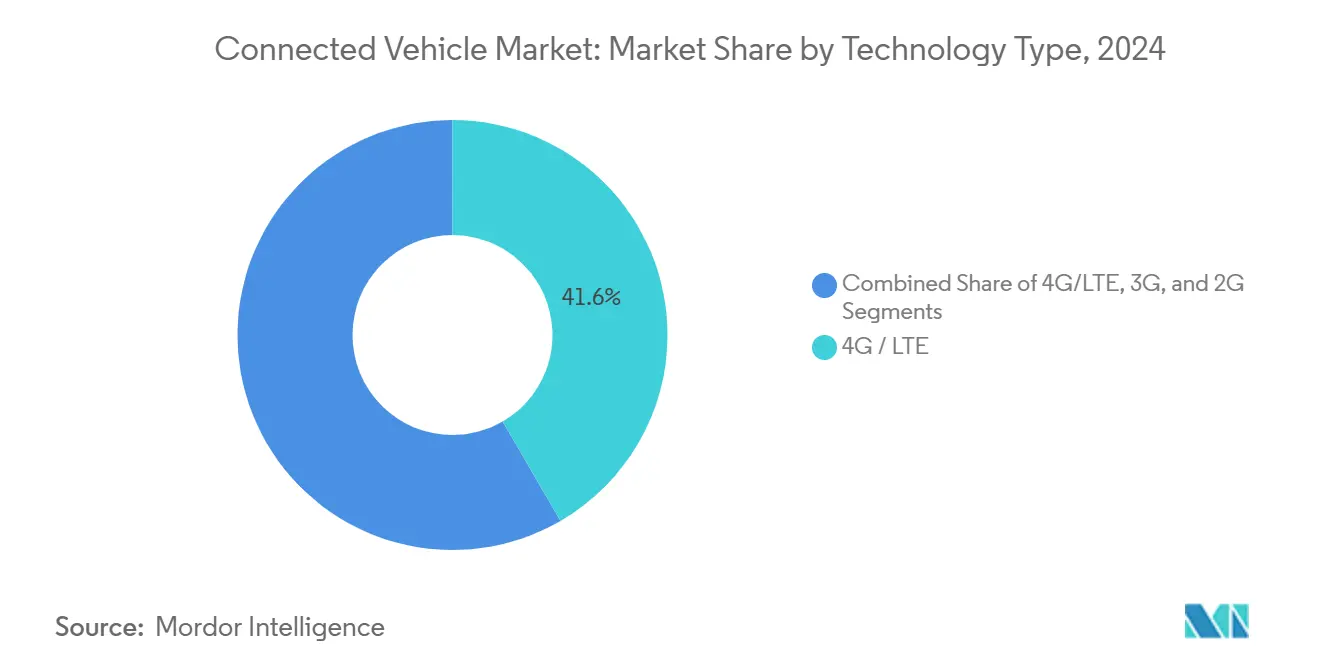
Note: Segment shares of all individual segments available upon report purchase
By Application: OTA updates reshape service models
Safety & Driver Assistance systems led revenue with a 36.74% share in 2024 because the EU General Safety Regulation made intelligent speed assistance and automated braking non-negotiable. Camera, radar, and lidar data flow continuously to centralized compute units, allowing real-time event logging that insurers increasingly request for usage-based policies. Over-the-Air update capability—embedded in 50 million vehicles in 2024 and set to reach 250 million by 2025—lets OEMs patch security flaws, recalibrate sensors for regional conditions, and unlock premium features such as heated seats or advanced parking aids. Early movers report a 20–25% reduction in warranty-related service calls after deploying full-vehicle software stacks that support delta updates instead of full image reloads.
Over-the-Air updates are forecast to expand at a 15.33% CAGR, outpacing every other application as consumers grow comfortable with smartphone-style feature drops. Continuous software refresh lowers recall costs by eliminating dealer visits, boosting customer satisfaction scores that influence resale values. Manufacturers monetize the data exhaust by feeding anonymized driving patterns into traffic-management platforms run by municipalities, creating ancillary revenue streams while improving urban mobility KPIs. Cybersecurity remains the gating factor; compliance with UN ECE R156 forces firms to operate 24/7 security operations centers that monitor anomaly signatures across global fleets. As a result, OTA competence is now a board-level metric for competitiveness in the connected vehicle market.
By Connectivity: Embedded solutions gain momentum
Integrated connectivity platforms, tight combinations of modem, antenna, GNSS, and eSIM, captured 44.85% of the connected vehicle market share in 2024, favored for their durability over a 10-year vehicle life. Tethered smartphone solutions persist in entry segments, yet inconsistent user experience and battery drain limit their appeal in regions with extreme temperature swings that accelerate handset degradation. Embedded modules are projected to grow at a 14.06% CAGR through 2030 as silicon prices fall and regulatory pressure for eCall-grade reliability intensifies. Continental’s 2025 aftermarket expansion includes quick-fit OBD-II dongles bundled with fleet dashboards, illustrating that retrofit demand endures where the average fleet age exceeds 12 years.
Factory-installed hardware offers superior event data recorder integration and supports vehicle health reporting that lowers the total cost of ownership for corporate fleets. Automakers negotiate multi-year data plans with mobile network operators, embedding global eSIM profiles that auto-select the least-cost carrier per roaming zone. This approach trims connectivity OPEX by up to 18% over legacy single-carrier contracts, improving the margin outlook for subscription services. As cybersecurity risk rises, embedded solutions benefit from hardware-root-of-trust chips that secure boot processes and encrypt in-flight packets, reinforcing their position as the default choice for new platforms in the connected vehicle market.
By Vehicle Connectivity: V2G emerges as grid integration driver
Vehicle-to-Vehicle (V2V) links accounted for 46.17% of 2024 revenues, underpinning collision-warning and cooperative lane-change functions now standard on many premium trims. Investments in municipal roadside units accelerate Vehicle-to-Infrastructure (V2I) rollouts, enabling green-light-optimized speed advisories that cut urban commute times by up to 11%. Vehicle-to-Pedestrian (V2P) beacons begin to appear in smartphone apps for visually impaired users, extending safety nets beyond metal to human mobility devices. Yet Vehicle-to-Grid (V2G) connectivity posts a 20.94% CAGR, transforming electric cars into distributed energy resources that buffer renewable intermittency.
European pilots show that 10,000 V2G-enabled EVs can offset the daily ramp-up of a mid-size gas-peaking plant, securing grid stability while generating USD 300–400 annual income per driver. Utilities in Denmark and the Netherlands now offer time-of-use tariffs that reward bi-directional charging, and Japanese regulators are drafting incentives that classify EV batteries as critical infrastructure assets for disaster resilience. Cyber-secure communication stacks based on ISO 15118-20 underpin the revenue settlement layer, guaranteeing that energy withdrawn from or injected into the grid is traceable for carbon accounting. These developments embed energy considerations into future platform design choices, further intertwining mobility and power markets within the connected vehicle market.
By Vehicle Type: Passenger cars dominate innovation
Passenger cars represented 71.24% of the connected vehicle market size in 2024 and are forecasted to register the fastest CAGR of 12.37% by 2030, reflecting widespread integration of infotainment, ADAS, and personalized in-cabin experiences that mimic smartphone ecosystems. Luxury marques spearhead immersive audio zones, wellness monitoring via seat sensors, and AI-based voice agents, features that cascade into mid-tier trims within two model cycles.
Commercial fleets prioritize uptime; telematics dashboards flag predictive maintenance intervals that cut unplanned downtime by 8-10%. Light commercial vehicles increasingly bundle route optimization engines that consider real-time congestion and charging availability, essential for last-mile e-commerce logistics. Medium and heavy trucks adopt asset-tracking beacons and cross-border data-roaming packages aligned with EU Mobility Package regulations. Despite disparate use cases, passenger vehicle innovation remains crucial for testing new revenue models that eventually migrate to enterprise segments, reinforcing their strategic weight in the connected vehicle market.
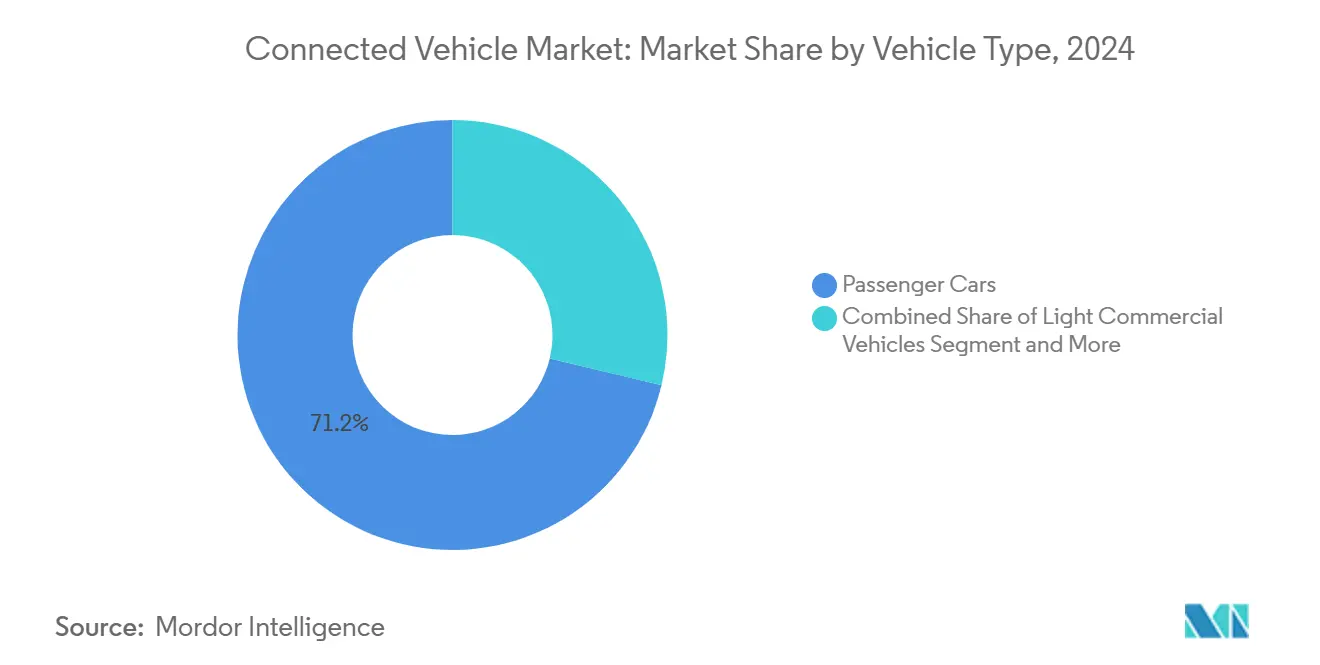
Note: Segment shares of all individual segments available upon report purchase
By End Market: OEM integration defines customer experience
OEM-fitted platforms captured 87.10% of 2024 revenues and are projected to rise at a 12.71% CAGR as automakers seek tighter control over brand experience and data monetization. Stellantis’ Mobilisights platform federates data from millions of cars into insurance, energy, and smart-city APIs, demonstrating the scale advantage of factory-installed telemetry. Automakers bundle connectivity in three-year service packs to reduce buyer hesitation, then pivot to paid renewals when customers have grown accustomed to digital add-ons.
Aftermarket solutions still appeal where the average car age tops 15 years, particularly in Latin America and Eastern Europe, but falling hardware costs and stricter cyber rules narrow the gap each model cycle. Independent telematics vendors pivot toward niche offerings—refrigerated cargo monitoring, asset-level carbon reporting, or specialized driver coaching—rather than head-to-head infotainment systems. As the UNECE cyber-security regulation widens its geographic reach, compliance certification becomes harder for retrofit devices, further tilting the market toward factory integration. These structural shifts entrench OEM platforms at the center of service delivery and create higher switching costs for end users within the connected vehicle market.
Geography Analysis
Geography Analysis
Europe held 33.55% of the connected vehicle market share in 2024, anchored by stringent driver-assistance mandates and early 5G corridors. Germany expects 873,000 new EV registrations in 2025, a 53% rise over 2024, while the EU Data Act, effective September 2025, forces OEMs to open data pipelines to third parties, catalyzing new service ecosystems. Vehicle-to-Grid pilots project that 50 million EVs could furnish roughly 4% of Europe’s annual electricity by 2030, embedding mobility deeper into the energy transition.
Asia-Pacific’s 13.90% CAGR stems from synchronized telecom and transport policies. China’s blanket 5G coverage lets OEMs validate V2X services under real-world conditions years ahead of global peers. Autonomous ride-hailing revenues leaped 200% year-on-year for leading firms in Q1 2025, underscoring commercial viability. Japan’s insurers integrate advanced driver-assistance data to refine premium models, while South Korea and Australia push early spectrum standardization. India’s Make-in-India incentives lure connectivity module suppliers, expanding regional value-add in the connected vehicle market.
North America posts a 12.5% CAGR, fueled by federal SMART grants funding V2I deployments and robust consumer appetite for software-rich electric models. General Motors rebranded OnStar Insurance to leverage telematics for personalized premiums in Arizona, Texas, and Illinois. Spectrum uncertainty between DSRC and C-V2X persists, potentially fragmenting standards across jurisdictions, but widespread 5G coverage and high willingness to pay sustain momentum.
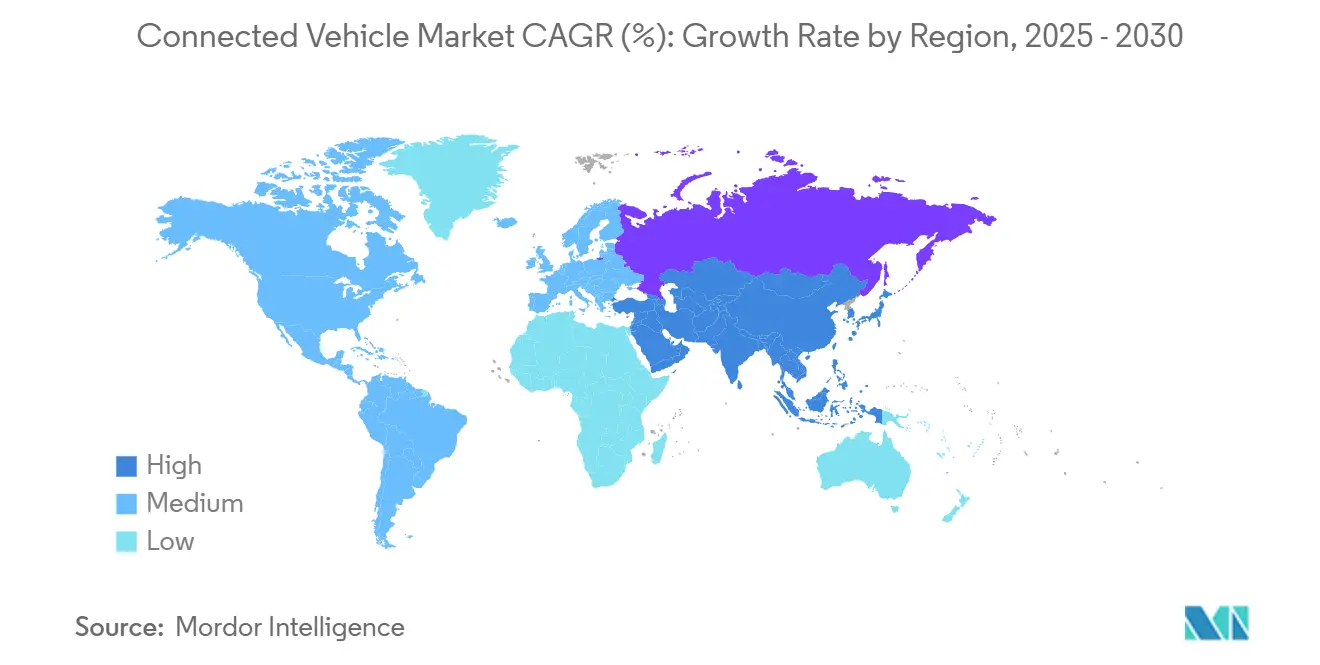
Competitive Landscape
The connected vehicle market is moderately fragmented. HARMAN’s recognition as General Motors’ 2024 Supplier of the Year signals the rising importance of software specialists in OEM strategies. Qualcomm and Amazon’s joint effort to fuse Snapdragon Cockpit with AWS cloud services aims to shorten development cycles and embed AI-powered user experiences.
Strategic archetypes divide into vertically integrated disruptors, horizontally aligned alliances, and platform suppliers controlling core architectures. Honda-Nissan merger talks, if finalized, would create the world’s third-largest automaker, conferring scale advantages in silicon procurement and code reuse. Supplier consolidation also proceeds: the completed Schaeffler-Vitesco merger pools electrification and connectivity competencies to counter tech-sector incursions. Meanwhile, specialized cybersecurity firms close gaps in cloud-vehicle links, and aftermarket connectivity pioneers address the aging global fleet, ensuring a lively innovation pipeline for the connected vehicle market.
Connected Vehicle Industry Leaders
-
Continental AG
-
Robert Bosch GmbH
-
Qualcomm Technologies Inc.
-
Harman International (Samsung)
-
Visteon Corporation
- *Disclaimer: Major Players sorted in no particular order
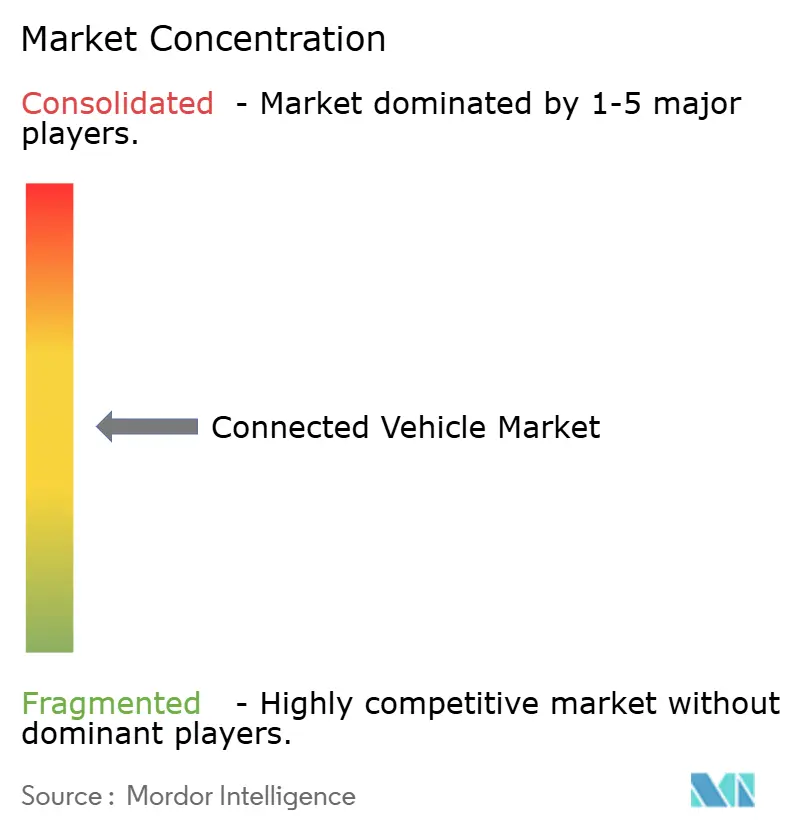
Recent Industry Developments
- January 2025: Amazon and Qualcomm Technologies, Inc. announced plans to collaborate on enhancing in-vehicle experiences by combining Qualcomm's automotive expertise with Amazon's AI and cloud capabilities.
- May 2025: HARMAN open-sourced a full connected-services platform with the Eclipse Foundation to support deployments for up to 100,000 vehicles.
- July 2024: HARMAN and CARIAD expanded Volkswagen Group’s in-vehicle app store to more than 70 apps.
Research Methodology Framework and Report Scope
Market Definitions and Key Coverage
Our study defines the connected vehicle market as all factory-built passenger and commercial vehicles that communicate bi-directionally with external networks through embedded, integrated, or tethered solutions covering V2X, telematics, infotainment, diagnostics, mobility, and over-the-air update services.
Scope exclusion: Pure aftermarket dongles and stand-alone navigation devices are outside the definition.
Segmentation Overview
- By Technology Type
- 5G / C-V2X
- 4G / LTE
- 3G
- 2G
- By Application
- Driver Assistance (ADAS)
- Safety and Security
- Telematics & Diagnostics
- Infotainment & HMI
- Mobility & Fleet Management
- Over-the-Air (OTA) Updates
- By Connectivity
- Integrated
- Embedded
- Tethered
- By Vehicle Connectivity
- Vehicle-to-Vehicle (V2V)
- Vehicle-to-Infrastructure (V2I)
- Vehicle-to-Pedestrian (V2P)
- Vehicle-to-Cloud (V2C)
- Vehicle-to-Grid (V2G)
- By Vehicle Type
- Passenger Cars
- Light Commercial Vehicles
- Medium and Heavy Commercial Vehicles
- By End Market
- OEM-Fitted
- Aftermarket
- By Geography
- North America
- United States
- Canada
- Rest of North America
- South America
- Brazil
- Argentina
- Rest of South America
- Europe
- Germany
- United Kingdom
- France
- Italy
- Spain
- Russia
- Rest of Europe
- Asia-Pacific
- China
- Japan
- India
- South Korea
- Australia
- Rest of Asia-Pacific
- Middle East and Africa
- Saudi Arabia
- United Arab Emirates
- Turkey
- South Africa
- Egypt
- Rest of Middle East and Africa
- North America
Detailed Research Methodology and Data Validation
Primary Research
Mordor analysts interviewed automakers, Tier-1 module suppliers, mobile network operators, and policy experts across North America, Europe, and Asia-Pacific. Conversations validated assumed telematics attach rates, region-specific ASP progressions, regulatory timing, and 5G-C-V2X roll-out milestones, closing gaps left by public data.
Desk Research
We started with traffic-worthy datasets from regulators such as the NHTSA, UNECE WP.29, and EU eCall registers, then layered statistics from ACEA production books, ITU 4G/5G penetration series, OICA vehicle stock data, and GSMA V2X deployment trackers. Annual reports and 10-Ks helped us capture model launches, connectivity take rates, and average selling prices, while Dow Jones Factiva and D&B Hoovers supplied supplemental company intelligence. These sources illustrate our foundation; many additional open and paid references supported fact-checks and clarification.
Market-Sizing & Forecasting
A top-down build began with 2024 light and heavy vehicle production, country-level connectivity penetration, and weighted ASPs; results were then sense checked through selective bottom-up roll-ups of supplier shipments and sampled OEM channel checks. Key variables include mandated eCall fitment timelines, 5G base-station density, EV sales mix (which skews toward higher connectivity), cyber-security regulation lead times, and average data-plan cost trajectories. Multivariate regression on those drivers projects demand to 2030, while scenario analysis adjusts for chipset shortages or delayed legislation. Any bottom-up shortfalls are filled by calibrated elasticity factors benchmarked from prior telematics waves.
Data Validation & Update Cycle
Outputs pass a three-layer review: automated anomaly scans, analyst peer review, and final senior sign-off. We refresh every twelve months, with interim updates triggered by material events such as spectrum rulings, mega-recalls, or >10% swings in quarterly shipments, ensuring buyers receive our latest vetted numbers.
Why Mordor's Connected Vehicle Baseline Earns Trust
Published estimates often vary because firms choose different service baskets, pricing ladders, and refresh cadences. Our disciplined scope selection and driver-level modeling keep estimates reproducible and transparent.
Key gap drivers are usually the inclusion of aftermarket dongles, divergent ASP assumptions for 5G modules, or the treatment of commercial fleets. Some publishers extrapolate from pilot programs without validating uptake, while others apply uniform global pricing. Mordor's model, anchored in verified fitment rates and region-specific price curves, avoids such skews.
Benchmark comparison
| Market Size | Anonymized source | Primary gap driver |
|---|---|---|
| USD 87.32 B (2025) | Mordor Intelligence | - |
| USD 98.39 B (2024) | Global Consultancy A | Includes aftermarket devices and bundles data-service revenue directly into hardware value |
| USD 14.49 B (2025) | Industry Journal B | Counts only embedded telematics control units, excludes integrated and tethered solutions |
In sum, by grounding every step in observable production, regulation, and technology adoption metrics, Mordor Intelligence delivers a balanced, decision-ready baseline stakeholders can replicate and trust.
Key Questions Answered in the Report
What is the current connected vehicle market size?
It reached USD 87.32 billion in 2025 and is projected to approach USD 151.29 billion by 2030 at an 11.62% CAGR.
Which region grows the fastest in the connected vehicle market?
Asia-Pacific, supported by ubiquitous 5G infrastructure and policy alignment, is forecast to expand at a 13.90% CAGR through 2030.
Why are OTA updates pivotal for automakers?
OTA functionality enables continuous software enhancement, post-sale feature activation, and recall-free security patches, supporting the fastest 15.33% CAGR among application segments.
How do EU regulations influence connected vehicle adoption?
The General Safety Regulation mandates advanced driver-assistance features, while the 2025 Data Act compels OEMs to share vehicle data, ensuring baseline connectivity across all new models sold in Europe.
What cybersecurity standards govern connected vehicles?
UN ECE R155 and ISO 21434 require automakers to implement end-to-end cybersecurity management systems covering design, production, and post-sale monitoring.
Can electric vehicles earn revenue through Vehicle-to-Grid services?
Yes, V2G pilots in Europe allow EV owners to discharge stored energy during peak demand, earning grid-stability payments and further integrating mobility into power markets.
Page last updated on:
